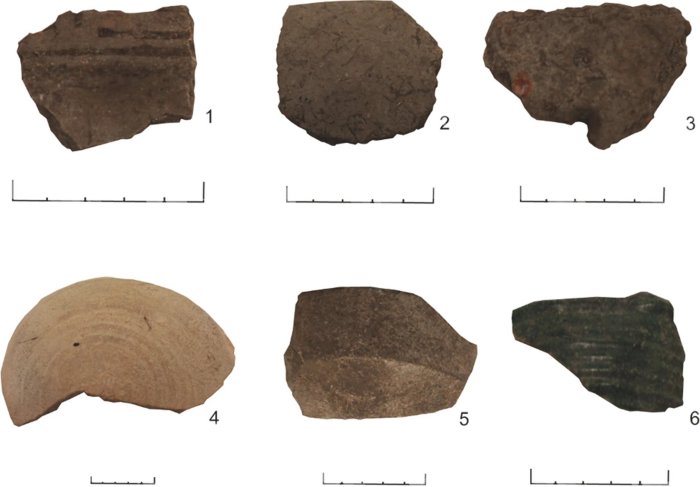Conny Waters – AncientPages.com – Scientists have found what they believe to be the earliest known evidence of wine drinking in the Americas, inside ceramic artifacts recovered from a small Caribbean island.
Forty ceramic sherds were examined in the first study to have used molecular analysis techniques—Gas Chromatography and Mᴀss Spectrometry—to investigate 15th century pottery from the Puerto Rico region.
Ceramic samples from the six categories of pottery analyzed. 1 = Chican-Ostionoid (217), 2 = Indigenous undecorated (231), 3 = buren (220), 4 = Spanish olive jar (175), 5 = European glazed (227), 6 = green bacin (229). Scale = 5 cm. Credit: Archaeological and Anthropological Sciences (2023). DOI: 10.1007/s12520-023-01771-y
The research focused on artifacts from the island of Isla de Mona, situated between the Dominican Republic and Puerto Rico. The findings, published in Archaeological and Anthropological Sciences, address questions around dietary changes and cultural exchanges in the Greater Antilles prior to and after European arrival.
Olive jar reveals earliest evidence of wine in the area
The study was led by Dr. Lisa Briggs, Visiting Researcher at the British Museum.
The analysis included sherds from a Spanish olive jar that could be dated between 1490-1520 AD. The rounded style of the jar shows it to be this early and aligns it to the timing of when Columbus first noted the existence of the island in his diary in 1494.
The olive jar, used then as a general container for all sorts of food and liquid goods, transporting them on Spanish ships, had evidence of wine residues inside.
“Whether consumed by Europeans or members of the Indigenous population, this is direct evidence for the importation and drinking of European wine to a tiny island in the Caribbean shortly after the arrival of Spanish colonialists,” say the researchers.
Fusion food experience over 500 years ago
As first generations of Spanish colonists brought European traditions of wine consumption to the area, despite their conquest over Indigenous people the local traditions for cooking on barbeques continued.
The researchers believe that barbeque cooking was commonplace among the Taino community, Indigenous to this area in the Caribbean, and adopted by early colonists. With no large mammals on the Caribbean islands in this area, it’s likely that the Indigenous population would have barbequed a large rodent-like animal called a hutier, as well as iguanas.
Indigenous people in this area of the Caribbean cooked fish and meat with charcoal over a raised grill, and the origin of the word ‘barbeque’ is traced to ‘Barbacoa’—a word used by the Taino people. The researchers suggest that in some ways, two culinary traditions came together—creating a fusion food and drink experience hundreds of years ago.
Dr. Briggs continued, “Two culinary worlds collided in the Caribbean over 500 years ago, driven by the early Spanish colonial impositions. We really didn’t know much about the culinary heritage of this area and the influence of early colonialists on food traditions, so uncovering the discoveries have been really exciting.
“The strong culinary traditions of the Taino people in creating the barbeque held firm despite Spanish colonialism, and influenced food right round the world. This continues today, as we are all familiar with a barbeque. I’m really pleased that this research shines a light on the cultural heritage of this community.”
Indigenous culinary traditions persisted despite colonizers
On excavating the area last year, scientists from the British Museum found many fish and meat bones around the site—but crucially none were found inside cooking pots.
In the Caribbean ceramics analyzed, there was no evidence they were used for dairy or meat products. While dairy products were long a staple of European cooking, this does not appear to be the case on Isla de Mona—giving further evidence that Indigenous culinary traditions persisted in the face of colonialism and imported ceramic vessels.
“This offers an interesting insight into culinary exchange on the island,” the researchers say. “…it appears traditional foodways were maintained even after an influx of European colonists arrived on the island with their glazed ceramics and olive jars. The lack of evidence for dairy products in our samples further suggests that European colonialists quickly came to adopt and rely on Indigenous culinary traditions.”
This indicates that the Indigenous people continued to cook proteins on charcoal over a raised grill, and vegetable dishes in the ceramic pots. This culinary tradition is far apart from the contemporary European preference for stews and cᴀsseroles—with cooking pots from that area often including meat remnants.
The research paper, “Molecular evidence for new foodways in the early colonial Caribbean: organic residue analysis at Isla de Mona, Puerto Rico,” involved a team of researchers from Cranfield University, Leicester University, the University of East Anglia, the University of York and the British Museum.
Paper
Written by Conny Waters – AncientPages.com Staff Writer






